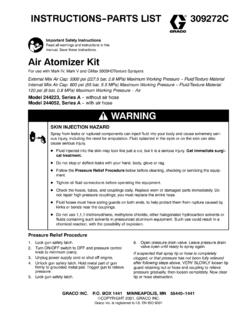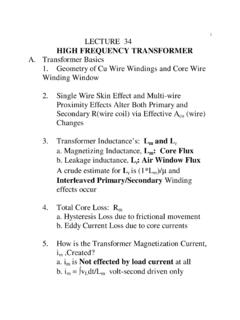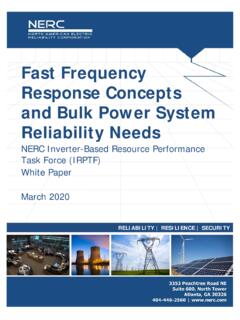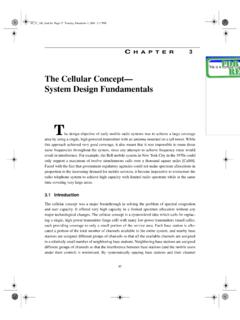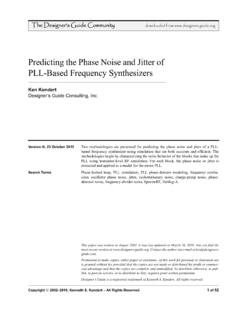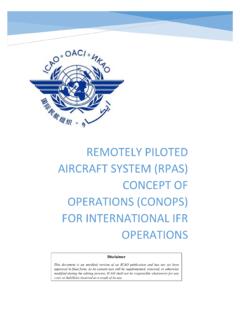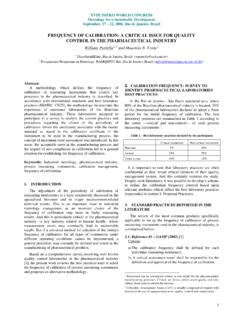Transcription of Atomization Concept and Theory - Graco
1 Graco , Inc. Box 1441 Minneapolis, MN 55440-1441 1995 Graco Inc. Form No. 321-027 8/95 Rev 2 SL Training 11/14 Atomization Concept and Theory Atomization Fundamentals Atomization Sprays, Droplets, and Surface Tension Atomization refers to the process of breaking up bulk liquids into droplets. Common home atomizers you may be familiar with include shower heads, perfume sprays, garden hoses, and deodorant or hair sprays. A classic example of Atomization occurring naturally involves pouring liquid from a pitcher. As you are pouring and gradually lift the pitcher higher, the stream of liquid elongates and breaks into droplets at some point. This breakup of a liquid stream is a simplistic example of Atomization . See Figure 1 for an illustration of this Concept . 05016 Figure 1 Atomization of a stream of liquid A spray is a collection of moving droplets that usually are the result of Atomization ; they are moving in a controlled fashion.
2 Naturally occurring sprays are rain and ocean sprays. See Figure 2 for a depiction of a spray from a gun. Note that there are a variety of droplet sizes in the spray. 05017 Figure 2 A spray stream with a variety of droplet sizes A droplet is a small particle of liquid having a more or less spherical shape. Droplets are also known as particles. The reason particles are round is due to the liquid s surface tension. Recall that surface tension is the property of a liquid that causes droplets and soap bubbles to pull together in a spherical form and resist spreading out. This property causes sheets or thin ligaments of liquid to be unstable; that is, they break up into droplets, or atomize. Have you ever accidently broken a thermometer and observed how mercury beads up? Mercury s resistance to spreading out is evidence of its high surface tension. You also may have observed this phenomenon with water; it has a tendency to bead up into droplets, especially on a waxed surface, like a car.
3 The chart in Figure 3 lists a number of common materials and their surface tensions. As the temperature of a liquid increases, its surface tension generally decreases. This becomes an important factor when handling certain fluids. Surface Tension of Common Fluids Liquid Surface Tension (Newton/meter at 20 C) Ethyl alcohol Soapy water Benzene Olive oil Lubricating oil Glycerine Water Mercury Figure 3 Surface tension of familiar liquids Fluid Properties Affecting the Spray A variety of factors affect droplet size and how easily a stream of liquid atomizes after emerging from an orifice. Among these factors are fluid properties of surface tension, viscosity, and density. Surface Tension Surface tension tends to stabilize a fluid, preventing its breakup into smaller droplets. Everything else being equal, fluids with higher surface tensions tend to have a larger average droplet size upon Atomization .
4 Viscosity A fluid s viscosity has a similar effect on droplet size as surface tension. Viscosity causes the fluid to resist agitation, tending to prevent its breakup and leading to a larger average droplet size. Figure 4 represents the relationship among viscosity, droplet size, and when Atomization occurs. 05018 Figure 4 Viscosity, droplet size, and when Atomization occurs Low Medium High Viscosity Density Density causes a fluid to resist acceleration. Similar to the properties of both surface tension and viscosity, higher density tends to result in a larger average droplet size. Progress Check Directions: After answering the following questions, compare your answers with those provided in the answer key following this progress check. If you respond to any items incorrectly, return to the text and review the appropriate topics. For items 1 through 4, match the terms with their descriptions. Terms a.
5 Droplets b. Spray c. Atomization d. Surface tension Descriptions 1. A collection of a variety of sizes of fluid droplets moving in a controlled fashion 2. Causes anatomized liquid to break up in to spherical droplets 3. Small particles of liquid 4. The process of breaking up liquids into droplets 5. Select the best description of the effect caused by surface tension. a. A resistance to beading up b. The tendency of liquids to form sheets or ligaments c. The opposite of viscosity d. The formation of spherical droplets Answers to Progress Check 1. B. A spray is a collection of a variety of sizes of fluid droplets moving in a controlled fashion. 2. D. Surface tension causes an atomized liquid to break up into spherical droplets. 3. A. Droplets are small particles of liquid. 4. C. Atomization is the process of breaking up liquids into droplets. 5. D. Surface tension is the force that causes fluids to pull together into spherical forms and resist the tendency to spread out.
6 Atomization Processes Pressure (Airless) Atomization Other terms the spray coating industry uses for pressure Atomization include airless, air-assisted airless, hydrostatic, and hydraulic technology. In the airless Atomization process, high pressure forces fluid through a small nozzle. The fluid emerges as a solid stream or sheet at a high speed. The friction between the fluid and the air disrupts the stream, breaking it into fragments initially and ultimately into droplets. The energy source for this form of Atomization is fluid pressure, which is converted to momentum as the fluid leaves the nozzle. Three factors that affect an airless spray include the atomizer orifice diameter, the atmosphere, and the relative velocity between the fluid and the air. Regarding orifice diameter, the general rule is that the larger the diameter or size of the atomizer orifice, the larger the average droplet size in a spray.
7 The atmosphere provides resistance and tends to break up the stream of fluid. This resistance tends to overcome, in part, the fluid s properties of surface tension, viscosity, and density. In addition, the air temperature may also affect Atomization . The relative velocity between the fluid and the air also affects droplet sizes. The fluid s velocity is created by pressure in the nozzle. As the fluid pressure increases, velocity increases and the average droplet size decreases. And conversely, as fluid pressure decreases, velocity is lower and the average droplet size is larger. Figure 5 illustrates a simple circular orifice injecting a round stream of fluid into the atmosphere. The fluid is under pressure and is breaking up into a spray. 05020 Figure 5 Airless Atomization with fluid under pressure Air (Air Spray) Atomization In air spray Atomization , fluid emerging from a nozzle at low speed is surrounded by a high speed stream of air.
8 Friction between the liquid and air accelerates and disrupts the fluid stream and causes Atomization . The energy source for air Atomization is air pressure. The operator can regulate the flow rate of fluid independently of the energy source. Figure 6 illustrates a stream of fluid passing through an orifice; as it emerges, a high speed stream of air surrounds the fluid stream. Note that other modules will cover the function of the horns you see on the illustration and the resulting spray patterns. 05021 Figure 6 Air spray Atomization with high-velocity air Note that sometimes you will hear the term conventional instead of air Atomization . Use of the word conventional is often ambiguous since many industry people use this term to refer to all non-electrostatic applications. Compressed air Fluid Compressed air Fluid Recall that it is the relative difference in velocity between fluid and air that causes Atomization .
9 Review the chart in Figure 7 for a summary of this Concept for airless and air spray Atomization . Then see Figure 8 which depicts a high-velocity water jet (airless Atomization ). Relative Initial Velocity Air Fluid Airless Atomization Slow Fast Air Spray Atomization Fast Slow Figure 7 The relative velocities of air and fluid for airless and air spray Atomization 05019 Figure 8 A high-velocity water jet that is breaking up by airless Atomization Centrifugal Atomization In centrifugal or rotary Atomization , a nozzle introduces fluid at the center of a spinning cup or disk. Centrifugal force carries the fluid to the edge of the disk and throws the fluid off the edge. The liquid forms ligaments or sheets that break into fine droplets. Figure 9 shows the mechanism of centrifugal Atomization . The energy source for rotary Atomization is centrifugal force. With the same rotational speed, at low flow rates, droplets form closer to the edge of the disk than with higher flow rates.
10 The spray pattern tends to move radially away from the disk or cup in all directions (360 ). With rotary Atomization , operators can control both the flow rate and the disk speed independently of each other. In most spray coating rotary applications, electrostatic charge is applied to the spray to attract the droplets to a grounded target object. In some types of atomizers, such as bells, shaping air can be added to move the spray forward in an axial direction. 05022 Figure 9 Centrifugal Atomization Fluid tube Spinning disk Atomization by ligament formation Electrostatic Atomization Electrostatic Atomization exposes a fluid to an intense electric field between the charged atomizer and grounded work piece. The charge transfers to the fluid and repulsive forces between the atomizer and the fluid tear the droplets from the atomizer and send them toward the work surface. See Figure 10 for an illustration of the Concept of electrostatic Atomization .



